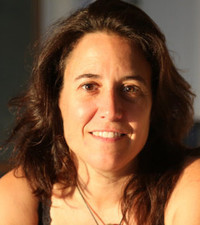Friday, July 29, 2016
Krisztina “Z” Holly, MAKE IT IN LA: Bridging Entrepreneurship and Manufacturing

Los Angeles is often thought of as just the city of entertainment and creative industries—but it turns out, it's a lot more. Krisztina “Z” Holly, founder of MAKE IT IN LA (www.makeitinla.org), found out that—in addition to both the entertainment industry and technology industry, it's actually the biggest manufacturing center in the country. We spoke with Z about how her new initiative—started with Mayor Eric Garcetti—is looking to elevate the manufacturing ecosystem in LA, and help connect it with LA's entrepreneurship, technology and startup world. Z also has recently launched a new podcast series, where she talks to entrepreneurs here at the intersection of entrepreneurship and manufacturing.
Tell us about MAKE IT IN LA, and what you are doing?

Why is manufacturing important to Los Angeles?
Z Holly: I think people don't realize that LA is the largest manufacturing center in the country. There are half a million jobs here in manufacturing, and we employ more people in manufacturing than in all of the creative industries combined. There are four times more people in manufacturing in LA than in film and television, which surprises a lot of people. We recently did a study, and we found that there were nearly 3,000 new businesses created in manufacturing here in the last three years. There is a really an opportunity to support that sector, which usually gets overshadowed by technology and Hollywood. We did the study to understand the ecosystem, which led us to launch this nonprofit with the major.
How did that effort come about in the first place?
Z Holly: It started with my role as Entrepreneur-In-Residence for the city and Mayor Garcetti. The program was supported by Ernst & Young. When the mayor asked me to become an EIR, I said yes, as long as I can focus on an under served part of the ecosystem here. I thought manufacturing was really interesting, but I didn't know what I was getting into. It's actually a very complicated area. That's when I decided to work with Dun & Bradstreet and the LA Chamber to do a comprehensive, first-of-a-kind study about the manufacturing ecosystem. We surveyed 1600 business in LA County, hosted focus groups, hosted a summit, and conducted a GIS analysis of 30,000 manufacturers, and found some interesting findings.
What were those findings?
Z Holly: The first, and probably the most important one, is that manufacturers here really want to stay local. They face some challenges, but at the same time, most of them are doing pretty well. They just need a little help in navigating the opportunities, they're interested in learning more about contract manufacturing, and they want to connect with capital. The most surprising one, is that 58 percent of manufacturers here have excess production capacity. That means that the majority of factories in LA are sitting idle part of the time. Meanwhile, you have other businesses in LA, who want to source locally, and don't know how to connect into the ecosystem. We found that entrepreneurs can really help drive manufacturing, and that excites me a lot. There's an opportunity to help entrepreneurs and startups here partner with manufacturers, and connect with customers and suppliers. I've learned things about both sides, both established manufacturers and the startup community, and ways they can help benefit from each other. Finally, we found that there are a number of resources here that are hard to find, and are just starting to pop up. I think we can really have an impact, by helping people to navigate and celebrate what's already here, rather than reinventing the room.
There's been a lot of debate in recent years over the cost of manufacturing here versus overseas. How do manufacturers here compete?
Z Holly: It's just depends on the circumstance. I'm not bullish to say every person should source everything from LA, or even domestically. There are just some things that are better to source overseas. Yet, there are things that are holding people back here, such as not being able to find suppliers. Also, sometimes, even though cost is a huge driver in making decisions, where sourcing locally you don't have to worry about lots of extra overhead and what it would cost. That's especially true of prototyping. If you look at fashion, for example, I just interviewed Karl Kani, the godfather of Urban Streetwear for our new podcast. I've talk to him many times about opportunities for sourcing locally, and how that is his secret weapon. He's able to turn around a design in two or three weeks, rather than waiting with no idea when it will come off a container ship from Asia. Sourcing locally is absolutely a secret weapon for him and some people. And, ultimately, even if a startup decides to source overseas, they can tap into the local system for knowledge, to pull in other service providers for prototyping, design, accounting, legal, and all of the things that really important to build in an ecosystem.
Finally, how was the experience as an EIR for Los Angeles?
Z Holly: I think it's really valuable to have a liaison, who lives at the intersection between government and the private sector. In a similar way, I played that role in academia, at both USC and MIT. At City Hall, I was able to hear from businesses, and uncover lots of opportunities to make things better. Because of that, the Mayor asked the Deputy Mayor of Economic Development to focus on manufacturing. The other thing, is it's really helpful to bring the same kind of thinking process that entrepreneurs and the technology industry has, and bring that into city hall. For example, one of the other EIRs, Eva Ho, brought her expertise to city hall to use data analysis and big data to address the homeless issue, for example.
Thanks, and good luck!